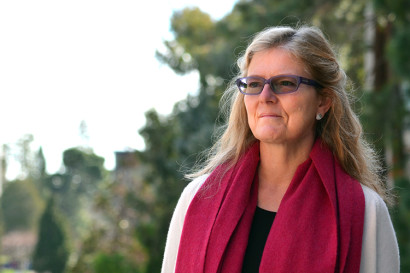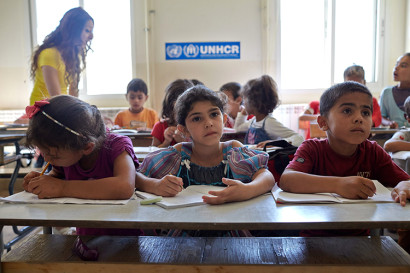The case for accepting more, not fewer, Syrian refugees
Kate Jastram, an attorney and UC Berkeley expert in forced migration, says closing U.S. doors to Syrian refugees would deepen America’s anti-Muslim reputation and alienate the 3.3 million Muslims already living here.
January 26, 2016
Immigrating to the U.S. is like free climbing Half Dome with a 50-pound pack. It can be a long, arduous process that presents challenging, and sometimes insurmountable, hurdles along the way.
For Syrians, who currently make up the single biggest refugee population in the world (aside from Palestinians), the ordeal is especially tough. Already subject to the most stringent screening process of any nationality of refugees, since the terrorist attacks on Paris, they — along with Muslims in general — have been demonized by some U.S. politicians as a direct threat to national security.

Kate Jastram joined the Blum Center for Developing Economies in January. She is currently teaching a course on the Syrian refugee crisis. (UC Berkeley photo by Anne Brice)
Kate Jastram, an attorney and an expert in forced migration with UC Berkeley’s Blum Center for Developing Economies, says it would be detrimental for the U.S. to close its doors to Syrian refugees. Not only would it intensify America’s anti-Muslim reputation, she says, but it would alienate the estimated 3.3 million Muslims living in the U.S., as reported by the Pew Research Center, or those who hope to migrate here.
“If we start saying, ‘Your religion is more important than anything else about you — your character, the suffering you’ve gone through,’this is a really dangerous and long road for the U.S to go on,” Jastram says.
The U.N. reports that since the Syrian civil war broke out in 2011, the number of registered Syrian refugees in the world has swelled to nearly 4.6 million. Only about 2,700 have been accepted for resettlement in the U.S., according to the Refugee Processing Center.
The majority of Syrian refugees and asylum seekers are living in countries that neighbor their homeland — the U.N. reports that Lebanon hosts more than 1 million, which amounts to 1 in 5 people in the country, and Turkey hosts more than any other country worldwide at 2.5 million. Others have headed to Jordan, Egypt and Iraq.

Most Syrian refugees seek asylum in neighboring countries, including Lebanon. (UNHCR photo by Shawn Baldwin)
But Jastram says living in these countries is not usually a good long-term solution.
“Often, refugees in countries of asylum don’t have a secure legal or economic status,” she says. “They become increasingly desperate just about living their day-to-day lives.”
So some Syrians have decided to make the often dangerous journey to seek resettlement in Europe. Germany has accepted some 93,000 Syrian refugees and has said it could take another 500,000 each year for several years, and France has promised to take 30,000 more Syrian refugees over the next two years.
Although refugees seek asylum across the world, only 28 countries take part in the UNHCR’s resettlement program, which offers refugees legal and physical protection as they transition to their new homes.
The U.S. is the top resettlement country. It has taken 70,000 refugees annually for the past several years and has upped the number to 85,000 in 2016 in response to the growing number of refugees, including the 10,000 Syrians the U.S. has approved for resettlement in fiscal year 2016.
Syrian refugees resettled in U.S., 2011-present
Total Syrian refugees in U.S. as of Jan. 26, 2016: 2,715

Source: Refugee Processing Center
Text version of map data
Although some conservative politicians expressed outrage at that number, Jastram says 10,000 is far too few.
“As a positive political measure, accepting 10,000 Syrians is not sufficient,” says Jastram. “I think it’s completely within the realm of possibility for the U.S. to take at least 100,000 Syrians. It would be a strong statement to our allies in Europe and our friends in the Middle East — the countries who are bearing that burden — by showing them that we’re willing to step up.”
Canada, with one-tenth the population of the U.S., has committed to accepting 25,000 Syrian refugees in six months; nearly 14,000 have arrived there since November.
Jastram says that because Syrian refugees have to undergo such extensive security checks for U.S. resettlement — it generally takes 18 to 24 months, and sometimes longer, to be accepted — people who want to cause the U.S. harm wouldn’t enter the country as a refugee. They’d more likely come in on tourist visa or some other temporary visa, she adds.

Jastram says one way Americans can welcome Syrian refugees is by helping Syrian kids integrate and succeed in school in the U.S. (UNHCR photo by Shawn Baldwin)
“Refugees aren’t the problem,” says Jastram. “It seems to be more a difficulty of assimilating people. Of really welcoming and supporting them when they get here, sending the message that you can be Muslim and American.”
UC Berkeley sociologist and immigration expert Irene Bloemraad says immigrants, especially the children of immigrants, can have a hard time feeling truly integrated into American culture, particularly given rising economic and racial inequality.
“Immigrants are often very thankful they were able to come to the U.S., so they’re willing to sort of look the other way when someone treats them unfairly,” says Bloemraad. “Children of immigrants, however, expect to be treated equally — like Americans — and when they’re not, there’s more potential for them to build feelings of resentment and alienation.”
As more Syrian refugees migrate to the U.S., Jastram says, Americans will naturally become more familiar with, and thus more accepting of, their Syrian neighbors.
“Usually, those who find asylum in the U.S. become sort of ambassadors for the U.S.,” says Jastram, “by upholding America’s roots as an immigration country. I think as more Syrians start coming, it will happen again. People will see that they’re just people.”
Kate Jastram is currently teaching a course on the Syrian refugee crisis. She was a longtime lecturer at Berkeley’s law school and, in January, joined the Blum Center for Developing Economies.